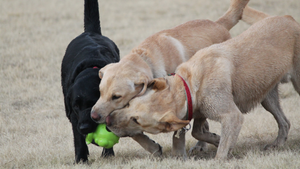
Doggie Playdate — a Social Pet App Study
Overview
Dogs usually have to stay home while their owners work. This limits the amount of exercise they get during the day. In our experience, many dog owners who want to socialize while their dogs exercise have a difficult time finding other dogs for a play date. In this project, we aim to improve the physical and mental health of dogs by encouraging and facilitating doggie playdates. Specifically, we asked how can we improve the experience of finding a doggie play date?
The goals of competitive products include tracking dog activity, online dating for dog owners, specific breed groups that meet regularly, and providing means for users to borrow someone else’s dog. However, none of the competitors aim to help owners find general dog play dates.
Methods
We started this project with observations (AEIOU Framework) at dog parks and a doggie day care between January 23 and January 24, 2016. We observed a range of dog owners and doggie daycare attendants from small children to middle-aged adults. We also observed a mix of dogs, from very small to large and puppies to adults. Each team member observed at least one dog owner and their dog. We recorded observations every 15 minutes to capture human and dog behavior and interactions. We created an affinity diagram (Figure 1) on Stormboard to analyze the observation data.
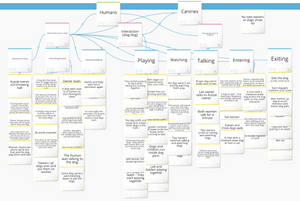
After analyzing the observation data, we found that most dog owners follow similar steps – arrival, playtime, and leaving (Figure 2). Dog owners generally did not approach each other or speak to each other. This interaction shifted when two dogs began playing together – the dog owners would approach each other at that point. Observed interactions included (1) human-to-human, (2) human-to-dog, and (3) dog-to-dog.
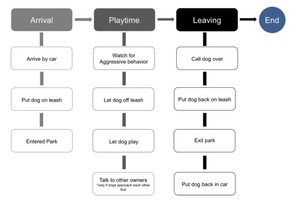
Two weeks after the observations, we conducted interviews with dog owners. We completed four interviews via Skype or in-person, after participants signed an informed consent form. All participants have dogs. To analyze the interview data, we created a spreadsheet that accounted for all questions asked, and recorded answers in the appropriate, aligned cell. We compared answers across the cells to understand the responses, then we created eight user spectrums to analyze the data (Figure 3).
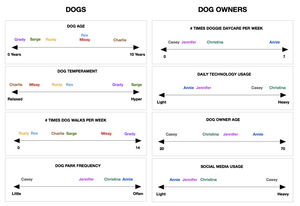
Owners have different sized dogs that enjoyed playing with other dogs. Owners tended to avoid other dogs if their temperaments seemed aggressive or overly active. All owners walked their dogs and had visited dog parks, but walk frequency varied from two times per day to once per week. Participants also reported using various methods to schedule playdates for their dogs, including: Facebook, text messages, or phone calls. Playdates included visiting a friend’s house for socialization, or organizing a hike on a local trail. All owners wanted a more convenient service to arrange playdates for their dogs.
Finally, we conducted an online survey via the DePaul Participant Pool. Surveys were anonymous, and participants responded from their personal computers, without any other human interaction. Thirty people responded, and their submissions were analyzed using a Kruskal-Wallis test. A few very obvious trends were documented:
- Dogs are more likely to be social with their owners and unfamiliar people, but not with other unfamiliar dogs.
- Dogs are more likely to be social with their owners and unfamiliar people, but not with other unfamiliar dogs.
- How active a dog owner’s lifestyle is has no effect on how often they exercised their dogs.
- Dog owners are more likely to hang out with their friends and their dogs once a month or less because of their busy schedules.
- Dog owners would love to have an app that allows temperament, age, breeds, and interests filtering to find other dog owners for playdates.
We also created a feature matrix (Figure 4) based on survey results, and the highest priority items were: event search based on dog breed, size, temperament, and age, make profiles for dogs based on size, calendar functionality to track dog’s playdate schedule, and location based search for doggie activities within your immediate area.
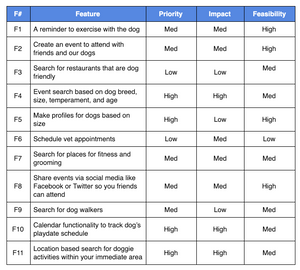
Findings
Overall, findings from research show that dog owners want an easier way to schedule play time with other owners and their dogs. Owner lifestyle does not seem to have an effect on the amount that they exercise their dogs, but busy schedules will keep them from spending time with other owners and dogs. Based on personas and user scenarios, there is an opportunity for an application - specifically mobile, to help dog owners find other owners while they are walking their dogs.
Documentation
Team Members
- Nick Dozier
- Lisa Garel
- David Hankes
- Alice Leung